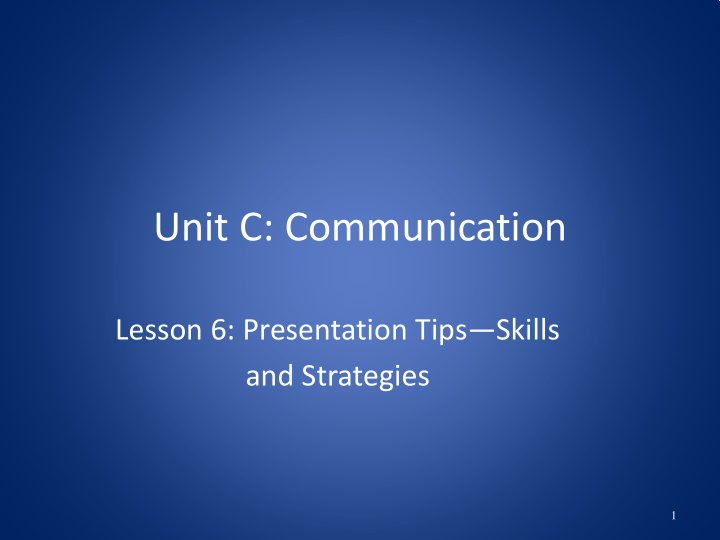



Unit C: Communication Lesson 6: Presentation Tips—Skills and Strategies 1
• What do the absolute best presenters — speakers, teachers, workshop presenters—do to make their presentations great ? • List at least five things they do during their presentation to make them great . 2
Great, great presentations . Meeting their needs is fun . Involving people and telling stories Will make me number one . 3
Meeting Audience Needs Auditory Learners – prefer to hear it Kinesthetic Learners – prefer to experience or do it Visual Learners – prefer to see it 4
Meeting Audience Needs Auditory Use music, discussions, voice, sounds, poetry, oral – directions, mnemonics, lyrics Kinesthetic Use actions, movement, physical activities, role plays, – writing, note-taking, team tasks Visual Use drawings, charts, pictures, computer slide shows, – transparencies, color, movies, maps 5
Interacting With the Audience Giving Directions 1. Be clear and concise, use action verbs—take, cut, paste, color, draw 2. Provide verbal and written directions if possible 3. Go step-by-step in the order the audience will do them 6
Interacting With the Audience Asking Questions 1. Use open-ended questions: why, how, what, where, when? 2. When inviting questions, ask, “What questions are there?” versus “Are there any questions?” 3. Step towards the audience and raise your hand when asking a question 7
Interacting With the Audience Providing Feedback 1. Compliment audience, both individually and as a group 2. Be sincere; don’t say, “That’s great!” every time 3. Use their names 8
Sharing personal life experiences • Best stories are personal experiences. • Structure of stories. – Set the stage. • Begin with who was involved, what happened, when it took place, and where it occurred. – Use descriptive language to paint the picture. • Describe the smells, sounds, tastes, and sights. – End the story with a learning point. • Have a reason to tell the story. 9
Sharing personal life experiences • Making stories memorable. – Appeal to the audience’s emotions—mix humorous and serious messages. • Take your audience on an emotional roller coaster ride. – Animate your body and use movement. – Vary your voice and use pauses. • Change your volume, pitch, and rate. – Utilize props and sound effects. 10
Review/Summary • How do I create a presentation that meets the needs of the three learning preferences? • How do you interact with and involve the audience in presentations? • How do you weave personal life experiences into presentations? 11
Recommend
More recommend